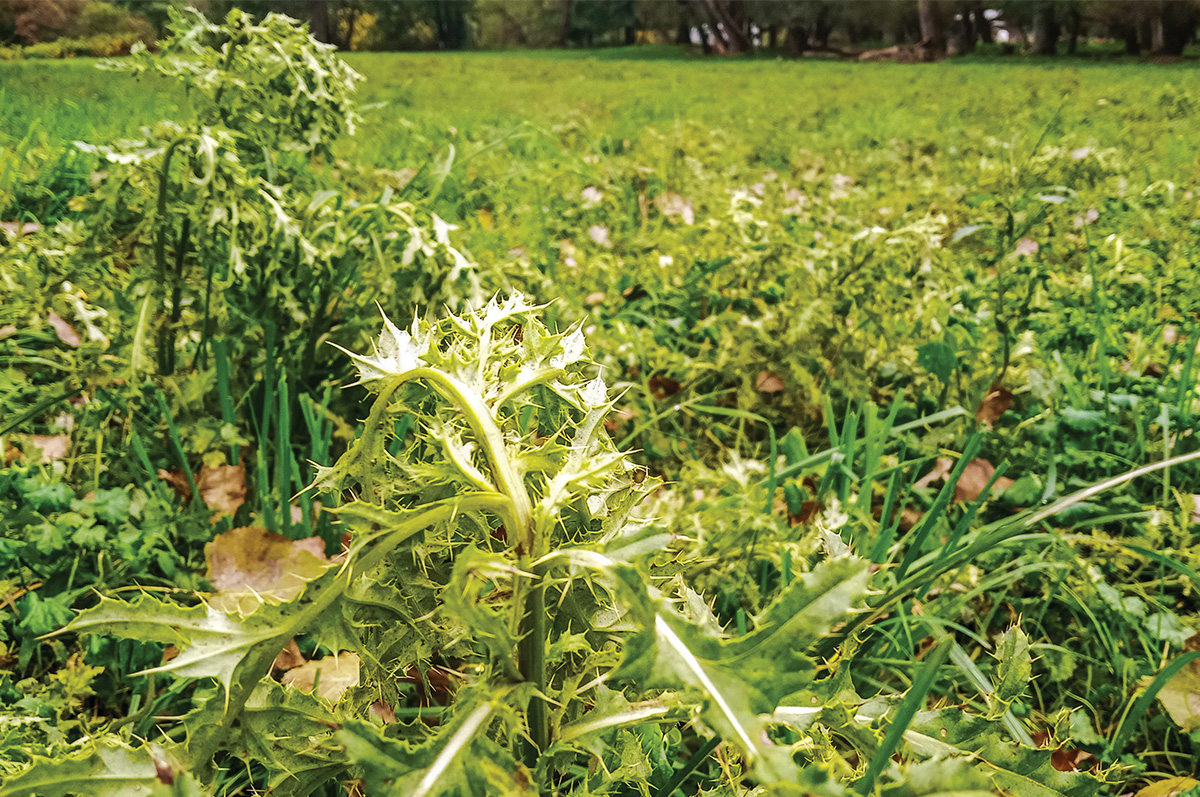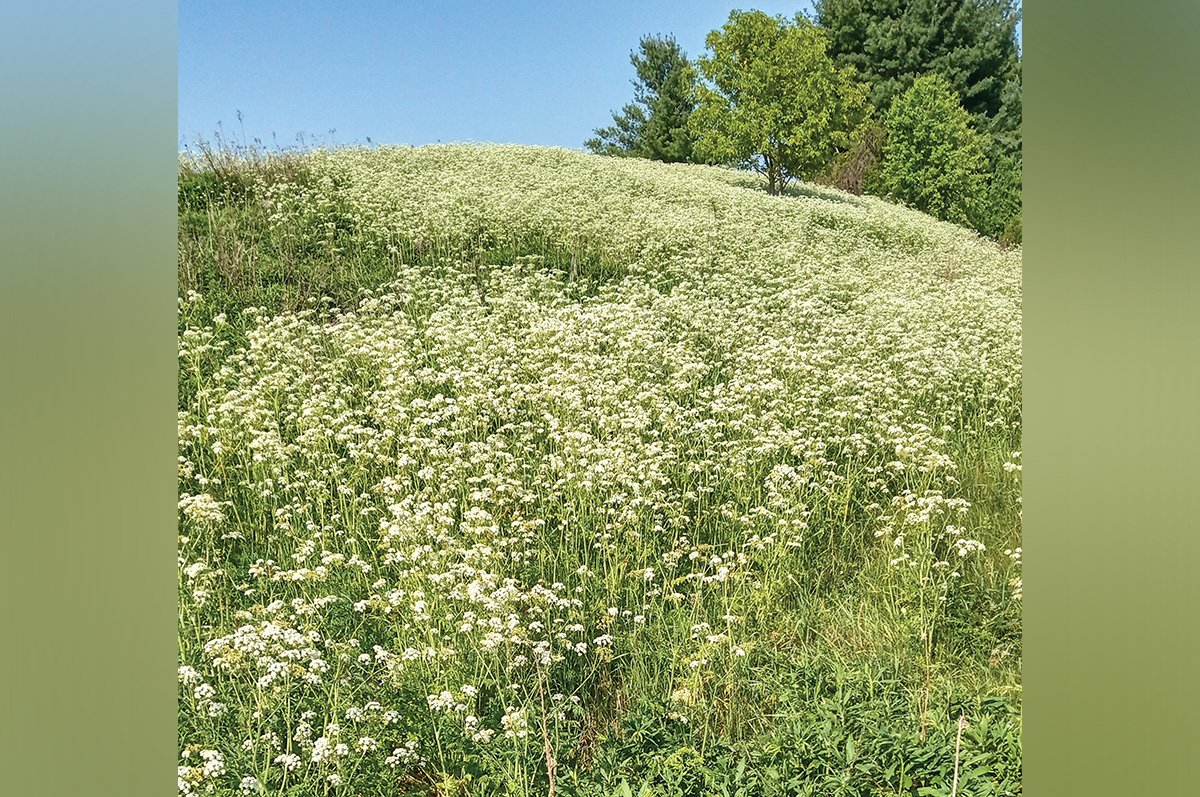Bodyweight alone may be the defining reason mature cows are not affected by toxins that can cause abortion in younger animals. Or perhaps it’s just, well, cow sense. Last year, when a first-calf heifer came open in the fall three months after she was settled, I looked back 30 to 45 days for a poisonous plant exposure – and got to spraying.
Many poisonous plants are toxic to the developing fetus at the 90- to 120-day interval of gestation. If you’re following a spring-calving season with delayed breeding of first-calf heifers until summer, it’s worth your while to pay particular attention to what weeds are growing that the cows haven’t eaten yet. Look for these toxic plants just before the first frost of the year. Even if that first frost is in the spring, take a look, as poisonous plants could also be the cause behind late-term stillbirths.
Ranunculus abortivus: Get to know this low-to-the-ground buttercup. Some call it littleleaf buttercup, smallflower crowfoot or kidneyleaf buttercup. This abortion-causing pasture weed is pretty common throughout New England, Mid-Atlantic, South Central regions all the way to the Texas Panhandle. It’s quite prevalent in Pennsylvania pastures, especially those with high water tables, slow-to-drain soils at the bases of woodlands, along streams and rivers that frequently flood. While the literature will state that cows avoid eating this plant and this plant is nontoxic when dried, I witnessed first-calf heifers actively grazing on an abundance of "frosted" plant material while older mature cows were chowing down at the feedbunk.
Look for this particular buttercup along rivers and streams that have flooded extensively in the past three years, as was the case with my farm. All buttercups are perennial. They are pretty easy to identify as they retain their leaves and green color even after a frost. And be diligent. Due to forb competition, weed seed spread by flooding may not germinate until later grazing seasons. Up-and-down spring temperatures and a warmup after a killing frost in the fall are two key triggers I’ve seen for a flush of buttercup to emerge.

Low-growing buttercups require a different approach than killing thistles. Photo by Melissa Bravo.
It’s never too late to treat buttercups. Plan to treat on a recurring basis once a pasture is invaded. Buttercups are cool-season plants and start actively growing around the same temperatures as field-planted lettuce. Unfortunately, there are more than 1,600 different kinds of buttercup species in the genus ranunculus, and quite a few are admired and cultivated by garden enthusiasts. Upstream and neighboring flowerbeds are likely sources of new infestations after a round of significant flooding.
Fall, mild winters, no snow cover, early spring temperatures or those crazy mild days in winter when there are consecutive days of 60ºF will allow for uptake and translocation of growth regulator herbicides. Pasture herbicides that have proven to control buttercup include MCPA, 2,4-D ester, dicamba and metsulfuron products. I personally saw poor control of mature plants with clopyralid and aminopyralid, which are two otherwise excellent herbicides for some other problematic pasture weeds. Be mindful of how you apply the product to maximize complete coverage, as these weeds are low to the ground and you don’t want to lose activity with volatility. For additional control information specific to your region, look for fact sheets on controlling buttercup in pastures and hayfields like these extension publications in Alabama, North Carolina, Pennsylvania, Missouri and Ohio. Plowing pastures, liming and reseeding for a denser stand of grass sward will go a long way to reduce infestations.
Nitrate accumulation abortions in cattle: Any grazing lands where row crops were growing should be suspect for excessive nitrate levels, as well as water sources in drainage areas. Nitrate toxicity can be acute and sub-chronic, or accumulating over time. And accumulate it does. Corn yields have seen a linear net gain in yield since the '90s. With average bushels per acre exceeding 170 bushels since 2014 nationally, corn is uptaking around 120 pounds of nitrogen. To achieve that, grazed corn stubble fields could easily have received upward of 200 pounds of fertilizer nitrogen and manure nitrogen. If growing conditions were not optimum for uptake and translocation of that nutrient to the ear, the nitrates can accumulate in the stalks, and not only in the crop but also in the weeds that could have cropped up since the last herbicide application. Nitrates could also accumulate in ponds, irrigation canals and mudholes.
Consider nitrate toxicity a probable cause if multiple abortions are evident within a week of grazing cropland or pastureland that has received nitrogen fertilizer or manure applications. Sudden turnout on lush late-summer grass species frequently makes the news as the cause of high mortality losses.
Ponderosa pine: Needles of Ponderosa pine (dark yellowish-green needles in bundles of three) are a common cause of late-term abortion in cattle. In Western states afflicted by fires, post-fire Ponderosa pine regeneration should be anticipated within close proximity of prior areas of pine stands. Research in Arizona by Northern Arizona University suggests that producers should be mindful of where exactly seedbanks of Ponderosa pine were as it may be several years, if not decades of shrublands and grasslands succession before a crop of Ponderosa pine reemerges.
Lupines and poison hemlock are two frequently encountered plant communities known to cause teratogenesis – congenital malformations like curly calf syndrome. Avoiding grazing lupines in the first trimester can greatly reduce incidences of fetal injury. Yellow-flowered poison hemlock is known to damage the fetus between 30 and 60 days in sheep.

A field of white is suspect for poison hemlock. Photo by Melissa Bravo.
Poison hemlock contains a central nervous system toxicant which even in small quantities can kill cattle. Be mindful that poison hemlock is a different species entirely from a similar yellow flowering plant known as western water hemlock, which is an even more lethal plant that targets the central nervous system, causing death nearly instantaneously. It’s a good idea to never handle umbrella-shaped white or yellow flowering plants, or plants with carrotlike leaves without wearing gloves and clothing that protects the skin. Remember, all members of the asteraceae family contain some level of phyto-photo sensitizing sap that can cause ultraviolet-induced skin burns and eye injury.
Broom snakeweed: Snakeweed (Gutierrezia sarothrae) is another perennial, yellow-flowered abortifacient in western North American sagebrush and desert shrub communities found from Saskatchewan and Alberta all the way down to New Mexico desert ecosystems.
Locoweed: Locoweed is a lump-it-together name for oxytropis and astragalus plants that cause problems for cattle owners. If cystic ovaries and altered estrus cycles suddenly become an issue on your farm, get out there and start looking for patches of these purple flowering plants with vetchlike leaves that are in the pea family.
Senecio species like fireweed and tansy ragwort can be found in different parts of the country. Most species have some level of toxicity to cattle. These daisylike, yellow-flowered plants have a decidedly negative effect on a cow’s liver.
Coffee senna: This shrub (Senna occidentalis) that has opposite leaves arranged like those we see on walnuts and locust trees is of limited range in the U.S. and has been linked to adult cattle deaths in Texas. It’s got a sickle-shaped seed pod and four- to five-petaled yellow flowers.
Additional plants of concern can be found on the USDA ARS Poisonous Plants By Syndrome page, or you can download the 2011 ARS publication Plants Poisonous to Livestock in the Western United States.
As cooperative extension master gardener and urban gardening programs continue to expand throughout all 50 states, so too will windblown seeds and large acreage pollinator plantings. It is a good idea to contact your local extension office, and land-grant university publications offices and let them know you are a cattle producer concerned about the spread of specific poisonous plants that are known to be desirable landscape additions. Ask them to update their outreach program materials and recommendations to include a section on dispersal by wind or flooding events into nearby grazing lands.
Melissa Bravo, Meadow Lake Farm, is the former poisonous plant and noxious weed program manager for the Pennsylvania Department of Agriculture.









